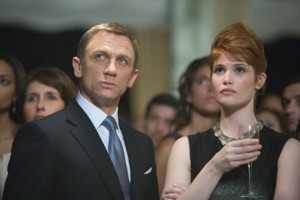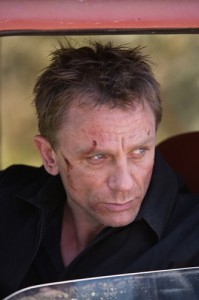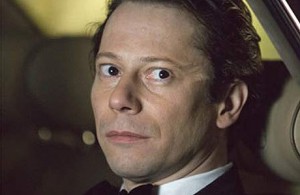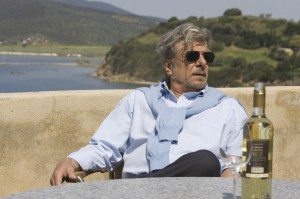Quantum of Solace
 One of the most amusing things about the influx of Bourne-style action movies is that it puts the filmmakers in a peculiar bind. The Bourne films take themselves very seriously, but amidst their constant globetrotting (I’d imagine Jason Bourne manages to fill up even his fake passports with travel stamps), they tend to stay in European countries, which are always shown as glamorous and state-of-the-art. When Jason Bourne does go to what might be though of as a poor or third-world country, it is often as a hiding place, or some straggling clue that can be extracted from a henchman by force, without worrying that the police might show up too quickly. If you’ve made a low-brow action movie, but it still maintains what the Bourne films are known for, a lot of quickly cut hand-to-hand combat instead of gun violence, jumping from exotic terrace to exotic terrace and smashing through the window without scratching yourself up, and a relentless pace to hide how repetitive they are, can you place your set-pieces in countries where the poverty is obvious and unavoidable without it seeming like tasteless exploitation?
One of the most amusing things about the influx of Bourne-style action movies is that it puts the filmmakers in a peculiar bind. The Bourne films take themselves very seriously, but amidst their constant globetrotting (I’d imagine Jason Bourne manages to fill up even his fake passports with travel stamps), they tend to stay in European countries, which are always shown as glamorous and state-of-the-art. When Jason Bourne does go to what might be though of as a poor or third-world country, it is often as a hiding place, or some straggling clue that can be extracted from a henchman by force, without worrying that the police might show up too quickly. If you’ve made a low-brow action movie, but it still maintains what the Bourne films are known for, a lot of quickly cut hand-to-hand combat instead of gun violence, jumping from exotic terrace to exotic terrace and smashing through the window without scratching yourself up, and a relentless pace to hide how repetitive they are, can you place your set-pieces in countries where the poverty is obvious and unavoidable without it seeming like tasteless exploitation?
 Director Marc Forster (Monster’s Ball, The Kite Runner, Stranger Than Fiction) and writer Paul Haggis (Crash, Million Dollar Baby) along with James Bond veterans Neal Purvis and Robert Wade, chose to have the largest action moments in Quantum of Solace take place in the Bolivian desert as well as in the depths of Russia, and have their story deal with political coups and third world droughts. Normally, this would be a disastrous choice for a James Bond film (they should be diversions, not “important” messagey epics), they tend to be shot in sleek locations and emphasizing the money spent on whatever hotel or casino Bond happens to be gambling in. James Bond movies are supposed to be meaningless and excessive, it makes it easier to accept the logic gaps and contrivances as well as the ridiculous stunts, and a Bond film is hardly revolutionary in any way, their goofy political irrelevance are part of their charm.
Director Marc Forster (Monster’s Ball, The Kite Runner, Stranger Than Fiction) and writer Paul Haggis (Crash, Million Dollar Baby) along with James Bond veterans Neal Purvis and Robert Wade, chose to have the largest action moments in Quantum of Solace take place in the Bolivian desert as well as in the depths of Russia, and have their story deal with political coups and third world droughts. Normally, this would be a disastrous choice for a James Bond film (they should be diversions, not “important” messagey epics), they tend to be shot in sleek locations and emphasizing the money spent on whatever hotel or casino Bond happens to be gambling in. James Bond movies are supposed to be meaningless and excessive, it makes it easier to accept the logic gaps and contrivances as well as the ridiculous stunts, and a Bond film is hardly revolutionary in any way, their goofy political irrelevance are part of their charm.
 However, the Daniel Craig starring Bond films are more serious and hard-edged. Bond bruises both physically and emotionally and the standard product placement play less like a way to show off their sponsors, but rather, a faintly more realistic world where Bond has to drive some kind of car, and it’s likely to be a famous brand. That’s not to suggest that these last two films, Casino Royale and Quantum of Solace are masterpieces of brooding and subtlety, they are just less jokey and self-aware than previous installments. Craig is well cast in this role for a lot of reasons, but the main one is the stiff toughness of his skin. He has Christopher Lambert features, as they both look like cyborgs with screwed-on heads that aren’t perfectly aligned. The scaling back of the excess was a good move, since the Bond films can no longer compete with the deliberate over-the-topness of recent Jason Statham vehicles like Crank or Transporter 2. The new Bond films are supposed to take place in a comparatively realistic world, making him easier to relate to. The previous films had Bond sleeping with every woman he came across and performing ridiculous stunts that had no intention of passing a believability test, the fantasy was the whole point, which is why, apart from the only film with George Lazenby as Bond, On Her Majesty’s Secret Service, Bond was like Teflon, neither women nor bullets ever stuck to him.
However, the Daniel Craig starring Bond films are more serious and hard-edged. Bond bruises both physically and emotionally and the standard product placement play less like a way to show off their sponsors, but rather, a faintly more realistic world where Bond has to drive some kind of car, and it’s likely to be a famous brand. That’s not to suggest that these last two films, Casino Royale and Quantum of Solace are masterpieces of brooding and subtlety, they are just less jokey and self-aware than previous installments. Craig is well cast in this role for a lot of reasons, but the main one is the stiff toughness of his skin. He has Christopher Lambert features, as they both look like cyborgs with screwed-on heads that aren’t perfectly aligned. The scaling back of the excess was a good move, since the Bond films can no longer compete with the deliberate over-the-topness of recent Jason Statham vehicles like Crank or Transporter 2. The new Bond films are supposed to take place in a comparatively realistic world, making him easier to relate to. The previous films had Bond sleeping with every woman he came across and performing ridiculous stunts that had no intention of passing a believability test, the fantasy was the whole point, which is why, apart from the only film with George Lazenby as Bond, On Her Majesty’s Secret Service, Bond was like Teflon, neither women nor bullets ever stuck to him.
In rewriting these rules, Casino Royale threw in everything, cramming in as many new facets of the series and character as possible, without completely betraying what made Bond popular in the first place. The consequence of the overstuffing is that Casino Royale was right on the cusp of two-and-a-half-hours, totally wearing the viewer out. Was it well made by director Martin Campbell? Yes, it was, but after the astonishing opening foot chase, there was a sameness to the action, and the mediocrity of the story, which should never be too much of a detriment in an action film, took over.
 Whether that caused Forster and Haggis to scale Quantum of Solace back is unclear, but the short running time (40 minutes less than Casino Royale) makes it easier to gloss over the myriad of problems. The drought plot is not developed very well, the only thing memorable about it is that Forster cast a villain (Mathieu Amalric) who looks exactly like Roman Polanski, who directed Chinatown, also about re-directing the public water source to force the locals to pay more for it. And from a distance, Forster and Haggis, two filmmakers who specialize in high-minded serious dramas, are exactly the wrong people to be helming a Bond film. But sometimes the worst theoretical combination makes an interesting film. Forster’s visual short-hand allows him to get across more information a lot faster (such as when Bond is upside down, sifting through glass to reach for a gun) than worrying about an abundance of look-at-me establishing shots and his skill at observing characters registering the crisis they find themselves, lends actual drama to what would normally be laborious exposition. Maybe that’s why the opening credit sequence, which looks like it was shot on the interior ceiling of a planetarium, is not so much a bothersome eyesore, but rather a palatable intermission that can be ignored since it adds nothing to the drama.
Whether that caused Forster and Haggis to scale Quantum of Solace back is unclear, but the short running time (40 minutes less than Casino Royale) makes it easier to gloss over the myriad of problems. The drought plot is not developed very well, the only thing memorable about it is that Forster cast a villain (Mathieu Amalric) who looks exactly like Roman Polanski, who directed Chinatown, also about re-directing the public water source to force the locals to pay more for it. And from a distance, Forster and Haggis, two filmmakers who specialize in high-minded serious dramas, are exactly the wrong people to be helming a Bond film. But sometimes the worst theoretical combination makes an interesting film. Forster’s visual short-hand allows him to get across more information a lot faster (such as when Bond is upside down, sifting through glass to reach for a gun) than worrying about an abundance of look-at-me establishing shots and his skill at observing characters registering the crisis they find themselves, lends actual drama to what would normally be laborious exposition. Maybe that’s why the opening credit sequence, which looks like it was shot on the interior ceiling of a planetarium, is not so much a bothersome eyesore, but rather a palatable intermission that can be ignored since it adds nothing to the drama.
 The credits aren’t the only issue that prevents Quantum of Solace from escaping mediocrity, the story points are half-explained and Forster assumes that you’ve watched Casino Royale no more than 45 minutes beforehand so you can keep up with who is who and why something is happening without giving us a clue. The action scenes are quick and the exciting ones are mostly in the first half as that last section in the desert is a really alienating mess. But Quantum of Solace is over quickly, so you don’t have time to wallow and linger. The only thing that may stick in your mind is the great Giancarlo Giannini, reprising his role as Mathis, an adversary-turned-friend for Bond. Giannini has a grizzled look to him now, but he retains the Charlie Chaplinesque charm that he had in the Lina Wertmuller films he made in the 1970s (Swept Away, Seven Beauties), where he used his malleable face to simultaneously make silly faces and intimidate. One can imagine that in his scenes with Craig, Giannini looked at Craig and thought to himself, “if I were a little younger and I could fake a British accent, I’d have your job.”
The credits aren’t the only issue that prevents Quantum of Solace from escaping mediocrity, the story points are half-explained and Forster assumes that you’ve watched Casino Royale no more than 45 minutes beforehand so you can keep up with who is who and why something is happening without giving us a clue. The action scenes are quick and the exciting ones are mostly in the first half as that last section in the desert is a really alienating mess. But Quantum of Solace is over quickly, so you don’t have time to wallow and linger. The only thing that may stick in your mind is the great Giancarlo Giannini, reprising his role as Mathis, an adversary-turned-friend for Bond. Giannini has a grizzled look to him now, but he retains the Charlie Chaplinesque charm that he had in the Lina Wertmuller films he made in the 1970s (Swept Away, Seven Beauties), where he used his malleable face to simultaneously make silly faces and intimidate. One can imagine that in his scenes with Craig, Giannini looked at Craig and thought to himself, “if I were a little younger and I could fake a British accent, I’d have your job.”



